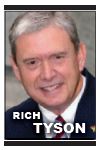Richard Tyson
Of all the dimensions of leadership, perhaps the most important (and often overlooked) aspect of leading is the development of a successor.
“Leadership is not defined by the exercise of power but by the capacity to increase the sense of power among those led. The most essential work of a leader is to create more leaders.”
These words were spoken by organizational behavior pioneer Mary Parker Follett in the early 20th century, and they are as true today as they were then.{mprestriction ids="1,3"}
Too often, this challenge is overlooked — most commonly in small-to-medium sized organizations — as the next generation of leaders assumes key roles. Among the reasons leaders give for this is their lack of bandwidth; they simply don’t have time for developing their successor.
Others naively suggest that their closest associates will develop on their own by simply being exposed tangentially to the issues and opportunities of leadership. I call this “leadership development by osmosis.” In other words, they’ll transform into strong leaders simply by paying attention to the boss. Unfortunately, this is most often an excuse for failing to explicitly create and act upon development plans for future leaders.
While there have been many articles written about succession planning, most are focused heavily on the financial aspects of transition rather than the performance and behavioral expectations for the successor.
Those often-overlooked aspects are encompassed in what authors Chris Zook and James Allen call the Founder’s Mentality in their book by that title. They emphasize the importance of a clear mission and purpose, an unambiguous owner mindset and a relentless obsession with the front-line operations where the business interacts with the customer.
The five-component template I use with my clients to develop this type of founder’s mentality uses the proprietary acronym PACER:
P: Performance assessed against the potential of prospective successors. Performance is a function of two key elements: 1. Each candidate’s record of personal contribution to the mission, purpose and outcomes (financial, customer, operations, etc.) of the enterprise, and 2. His/her leadership behaviors.
The first element of performance, their contribution to enterprise outcomes, is generally measurable and comparatively easy to assess. The second, leadership behaviors, is not. For this reason, the remainder of the PACER model is focused on key leadership behaviors:
A: Agency. This deals with how each candidate makes decisions. Is she prone to quick shoot-from-the-hip decisions (what I call “ready-fire-aim”) or more likely to over-deliberate, to suffer from “analysis paralysis”? Does she engage with other key stakeholders in decision-making and daily operations? Does she seek input from the front line, from your customers and the people who most directly interact with them?
C: Communication. How does the candidate communicate and evangelize the mission, purpose and strategies of the enterprise? Does he inspire, build engagement and facilitate problem-solving? Is he able to articulate in verbal, written and non-verbal ways?
E: Emotional Intelligence. Does the candidate exude humble confidence, awareness of others and herself, sincere empathy and kindness and optimism?
R: Responsibility. Does he readily take ownership for the challenges of leadership? Is he adept at sharing his load without dumping it on others? Does he learn from his mistakes and the mistakes of others without resorting to blaming? Does he recognize that “the buck stops with him”? Does he have a clear sense of the challenges he will face in the top job?
It is important that the current leader, CEO, owner or founder assess not only each candidate’s performance to date but also their potential to grow into leadership. Failure to evaluate both performance and potential may result in the elimination of viable candidates.
A frank and honest assessment of each candidate against the PACER template will provide a baseline for consideration of each successor to lead your enterprise to — and through — transition. The use of this model is best pursued in a careful and deliberate manner, often with the facilitation of an objective coach from outside your company.
Ultimately, as you zero in on both performance and potential, your assessment should be shared with each viable candidate. This will provide the basis for a plan to bridge any gaps between potential and performance. That plan should then be vigorously implemented.
Ideally, the process of developing one’s successor should not be left as a last-minute process. You should start early, allowing at least two to three years, if possible.
Finally, avoid what I call the “heir apparent” syndrome. Strive to get more than one prospective candidate into your successor pipeline. This competitive aspect tends to make each candidate more focused on bridging the gap between their potential and performance, and it reduces the risk should your only candidate be unable to fill the position.
Richard Tyson is the founder, principal owner and president of CEObuilder, which provides forums for consulting and coaching to executives in small businesses.{/mprestriction}








